Super thrilled to have an independent bookstore in Kits.
Sitka Books & Art
2025 West 4th Ave.
Vancouver, BC, V6J 1N3
Tel: 604-734-2025
Fax: 604-734-2056
Email: info@sitkabooksandart.com
Store Hours: 10 a.m., 6 p.m.
7 days a week
Plain words, uncommon sense
Super thrilled to have an independent bookstore in Kits.
Sitka Books & Art
2025 West 4th Ave.
Vancouver, BC, V6J 1N3
Tel: 604-734-2025
Fax: 604-734-2056
Email: info@sitkabooksandart.com
Store Hours: 10 a.m., 6 p.m.
7 days a week
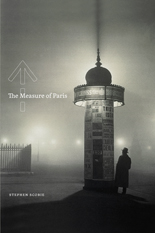
Measure of Paris by Stephen Scobie (published by the University of Alberta Press) is a travelogue, memoir, literary criticism and poetic look at Paris.
Quote: From the UofA site:
Paris remains one of the most fascinating cities in the world. It provides a measure of excellence in many areas of culture, and it is itself constantly being measured, both by its lovers and by its critics. This book presents a series of studies on the images of Paris presented by writers (mostly Canadian, from John Glassco to Mavis Gallant to Lola Lemire Tostevin), but also in such other areas as social history and personal memoir. The result is a wide-ranging discussion of the city’s history in 20th century literature and thought, which will appeal to all those who love Paris, or who have ever walked on its streets.
Scobie is the ultimate flaneur and his philosophical meanderings through Paris takes readers to sites of art, architecture and transit. His history of the city planning, and the itineraries of Canadian writers in Paris, makes for interesting reading and a different look at a city that is larger than life.
His personal musings were my favourite, along with the insights into Haussman’s influence and transformation of Paris through the large-scale construction of the streets and boulevards that make the Paris we know today.
Take a deep breath. Just breathe. Keep breathing.
WHO defines health as a state of complete physical, mental and social well-being and not merely the absence of disease or infirmity.
Despite knowing that the foundations of health are preventative measures, we live with a health care system that deals with us only when there is disease or infirmity. We are left on our own to figure out nutrition, exercise and the mind-body connection.
In the last year, I’ve learned a surprising amount about how much breathing is related to general health, in particular to levels of stress. (Thank you internet, Lucy Miller, Rubina Kirji, Debra Gibson and the Westcoast Women’s Clinic.) I’m astounded at how long it has taken me to piece together some of these basic tenets of good health. Now I want to share, especially with all the women in my life who are suffering from fatigue, digestion issues, and other work-life imbalances. (Oh the boys should read this too.)
Here’s what I know and what your GP doesn’t tell you (or doesn’t know).
There’s a critical link between meditation, deep breaths and health.
Let’s start with some body basics and definitions. (Come with me back to grade 10 biology. It’s time to fill in the blanks.)
Hormones are chemical messengers that travel through the blood and enter tissues. They turn on genetic switches that regulate everything from reproduction to emotions, general health to well being. Different glands and organs produce different hormones.
Pituitary: Master gland in your brain that controls how much of certain hormones are released
Adrenals: Little walnut-shaped glands on top of your kidneys that secrete hormones like Cortisol, Adrenaline, DHEA, Aldosterone
Pancreas: Glandular organ that produces digestive enzymes and the hormones insulin and glucagon to regulate blood sugar.
Thyroid: Butterfly-shaped gland located on the front part of the neck below the Adam’s apple that produces thyroid hormones, which regulate body energy, the body’s use of other hormones and vitamins, and the growth and maturation of body tissues.
The Adrenals Hold the Key
The hormones produced by the Adrenals play a special role in stress reduction.
DHEA: stamina, vitality, muscles
Cortisol and Adrenaline: stress, fight/flight
Aldosterone: fluid and electrolyte balance
If we are stressed out all the time, we tap out the adrenals. Why?
When you’re stressed, cortisol is released into the bloodstream. The positive effect is the quick burst of energy that lets you run away from a tiger or fight off a predator. The problem is that we aren’t often stressed because of tigers and predators. We are usually desk bound and stressing about our job, our family, or the to-do list and the lack of time.
That fight/flight cortisol triggers a set of physiological changes, such as increases in heart rate, arterial blood pressure, and blood glucose (blood sugar). It’s your sympathetic nervous system kicking in to mobilize your body in response to stress. (Stress Health and Cortisol)
Cortisol is released > sugar in the blood increases
This is the ALARM phase where we are stressed but productive. We’re wired. We have a little energy high because of this panic mode.
If we burn off the sugar running away from that tiger (or exercising), insulin takes whatever sugar is left and typically puts it back into the tissue cells (muscle, kidney, fat) to use for energy.
But when we don’t burn off the sugar in the blood, insulin stores the excess in the liver by making glycogen, long chains of glucose, and it stimulates fat cells to form fats from fatty acids and glycerol.
Since the tissue cells are depleted of sugar (energy), we crave carbs, which are an immediate source of sugar. But because the body still thinks it’s stressed, insulin continues putting the sugar into the liver, making more glycogen and stimulating more fat.
If you’re stressed, and hardly eating, but still gaining weight. This is why.
If that cycle repeats because we’re in a constant, low-level state of stress, tissue cells don’t get the energy from glucose and their sugar levels crash. We crash. We are exhausted. We’re stressed and have no energy. We can’t relax. We are wired but tired.
This is the MALADAPTIVE stage.
If the stress continues for prolonged periods, your cortisol and adrenaline levels are low. You have no energy. “I just can’t do it anymore.” You need 4-5 days of vacation before you even feel a little release and relaxation. You are burned out. Feeling burned out is adrenal burnout, or the FATIGUE phase.
Insulin resistance can take place, which is when insulin becomes less effective at lowering blood sugars.Your body either does not produce or does not respond to insulin, your cells do not absorb glucose from your bloodstream, which causes you to have high blood-glucose levels. (This is the basics of How Diabetes Works.)
You don’t want to get here!
Adrenal dysfunction can be avoided with good nutrition, reframing our stress response, minimizing environmental stressors (toxins), meditation (especially creating a relaxation response vs. fight/flight response) and exercise.
Deep meditation (purposeful, deep breathing for 20 minutes) can right your cortisol levels for 24 hours. You want that. Do it.
Can’t sleep at night? It’s likely because your cortisol levels are high. You can’t sleep because your brain and body is in a fight/fight response vs. a relaxation response.
Go to bed before 10 pm so that you don’t get that second wind that keeps you up. It’s a cortisol peak that is keeping you up.
When you have nice functional adrenal glands, your cortisol peaks around 6 am. You do not wake up tired. You do not wake up in the middle of the night. You are not overwhelmed. You are not sick all the time. And you should not have allergies and sensitivities.
Now good nutrition is tricky because very few of us understand nutrition. You know the basics:
* Do not skip meals
* Anticipate hunger and eat before (no crashes)
* Slow down and chew your food
* Don’t eat on the run
The sympathetic nervous system that creates the stress response inhibits salivation and digestive activity. When we eat on the run, the first stage of digestion (salivation) is not working. Nor is the digestive system. Sluggish? Bloated? This is why.
You want to initiate the parasympathetic nervous system, which stimulates salivation and digestive activity. Eating bad food while relaxed is better for you than eating good food when you’re stressed out. When you’re relaxed, the body can extract the nutrients and convert them into energy properly. When you’re stressed, your whole system is under stress and underperforming.
If you’re stressed, take 10 deep breaths. Pause right now and do it. I’ll wait.
Now, of course, you have to eat but you need to choose low GI foods, foods low on the glycemic index that don’t convert to sugar quickly:
* whole grains (whole wheat is not the same as whole grain)
* brown rice
* quinoa
* beans, lentils
These foods stabilize insulin.
Avoid white flour, white rice, white sugar.
Go for protein, pasture-fed (free range) meats, wild fish, eggs, dairy, which all stabilize blood sugar.
Choose good fats (from plant sources vs. animal sources). Eat 6 almonds.
Plus, pay attention to how you combine foods in a meal. Certain things go better together and make for easier digestion (for example, combine fruit with protein or good fat).
Avoid fruit juice (we give this to diabetics when their sugar drops). You don’t need the sugar spike.
Chocolate, caffeine and alcohol are all incredibly difficult for your body to process if it’s in a state of adrenal fatigue. Just don’t do it. If you’re trying to correct poor health or stress, you’re only cheating yourself by indulging. Help your body out. Supplements, exercise and medication alone can’t do it.
Exercise
Go for a combination of weights, cardio and flexibility. And if you are in adrenal fatigue, make sure that you’re not over exercising. If you are exercising, and feel good for a shot time but then crash, you need less exercise until your adrenals recover.
Meditation
Take a deep breath. Just breathe. Keep breathing.
Breathe with your whole body. Let your stomach inflate. Feel your diaphragm fill to capacity. If you’re taking shallow breaths, or not letting the lower part of your diaphragm do it’s job, your brain takes this as a cue that you’re under stress. Short breaths. Panic. Sugar energy. Run. You have to break this cycle. At least for 20 minutes a day.
Can’t do 20 minutes? Find time for 10 deep breaths a day. While you’re waiting for the bus. Getting in and out of the car. Waiting for the photocopier. What do you do throughout the day that could act as a trigger to take a small pause? Find it. Do it.
20 minutes a day resets your cortisol levels for 24 hours. You’re going to like that and sleep better.
Neuroscientists are only beginning to understand the powers of the brain. We now know that the meditating brain is a brain with increased capacity for positive emotion. Just what we need to fight stress.
What the Dalai Lama knows about neuroscience.
Simply breathing can lead to better health.
Who’s going to join me in my 20-minutes a day meditation resolution?
I’m teaching Pub355: Online Marketing for Publishers at Simon Fraser University.
On Friday, I explained how university students in 1997 would have accessed magazine articles published prior to that year.
* go to the library
* search the internal system or the card catalogue to find the shelf reference number (if there was a physical copy available) otherwise go to the special librarian to get the microfiche
* schedule time to use the microfiche reader
Microfiche: Microfiche is a card-shaped piece of photographic film, usually 4×6 or 3×5 inches in size, used for the storage of miniaturized text in a grid pattern. It can be read only with the aid of magnification by use of a microfiche reader. Microfiche may contain a printed book, journal, or newspaper. (Source: lib.uwo.ca)
How fun does that look?
What ancient technology can I explain this week? Maybe the dictaphone (which is a word my spell check does not recognize).
Dictaphone Parcel from Lauri Warsta on Vimeo.
Good article in the Globe and Mail this weekend about the film business, the long tail and how digital changes everything.
Have a read and remember Chris Anderson’s Theory of the Long Tail:
The democratization of the tools for production, democratization of distribution, and the ability to connect supply with demand has a huge impact on the cost of reaching customers, the choice in the market, changes to consumption patterns and a move from a small number of hits to a large number of niche products.
We see here the long tail of theatre revenue: ticket prices, popcorn.
We see the “experience” change as this media business discovered what they could upsell to make up for falling revenue: 3D, specialty food, games, dvds.
The cost of distribution (digital vs. film reels) should have decreased the ticket price. Instead it has increased and we’re blind to that because we’re paying for the upsells, or the experience.
Books, magazines and newspapers need to figure out the upsell.
Read the full article in the Globe and Mail.
In “The economics of the movie business” reporter Susan Krashinsky looks at what’s driven the film industry lately, and what will propel it in the future.
What fuels the industry? Studios + theatres
What’s driving the industry: Concessions and popcorn profit
“Cineplex gets roughly 59 per cent of its revenue from the box office and 30 per cent from concessions, but the real profit is in popcorn. Theatres’ profit margins on a movie ticket are roughly 48 per cent of sales, but they get to keep about 80 per cent of what you pay for food. In the United States, those margins are closer to 90 per cent.”
How are things in Canada?
“Cineplex chief executive officer Ellis Jacob said. ‘We do a lot more money per person than [the U.S. chains] do, and the reason is we’re giving you more choice.'”
Help us all. Apparently theatres will go the way of airports. Self-service drinks and payment processing.
What’s up with 3D and digital?
3D lets the theatre charge a $3 premium.
Why switch to digital projectors and 3D? Big savings
Pay attention to Anderson.
Digital is cheaper to make and ship than film reels.
“For Imax, a film print for one of its big screens costs about $20,000 (U.S.) while a digital print is closer to $200. Regular movies are about $1,200 (U.S.) on celluloid, but the savings on the digital are still significant for the studios, and agreements are in the works to subsidize those prints so the cost is neutral for exhibitors.”
Premium tickets: Everyone can be a VIP
When you can no longer charge the same for a digital experience as you could for a physical one, you have to find new things to sell. New points along the demand curve. For movies, it is 3D and premium tickets for reserved seating, leatherette chairs, bigger screens, VIP auditoriums for 19+ viewers, in-seat concession services and booze.
The international market is seeing fast growth
If you make a film with an international audience in mind, then you can capitalize on the marketing to an international audience. Rich Gelfond, CEO of Imax, cites the movie Inception, which is shot in various locations from Tokyo to Paris. “As studios try to sell to more global audiences, he said, they’re trying to look more global too.”
Global action: Imax follows the global trend
Fill in the blanks by reading the full article: Globe and Mail
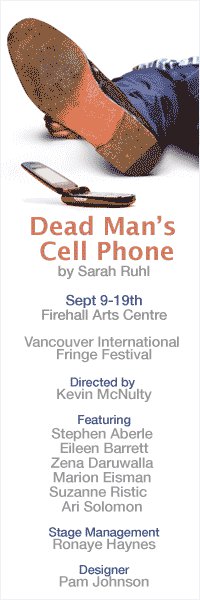 Sunday is your last chance to see Sarah Ruhl’s oddball comedy that confronts two of life’s inevitabilities: death and cellphones.
Sunday is your last chance to see Sarah Ruhl’s oddball comedy that confronts two of life’s inevitabilities: death and cellphones.
Dead Man’s Cell Phone
Sunday September 19 2010 at 7:00 PM
Firehall Arts Centre 280 East Cordova St
My arty friend Rachael Ashe has her altered book art at a couple of awesome shows this fall.
(e)motive: Artist’s Books
An exhibition of over 100 national and international experimental altered and artists’ books, curated by Emma Powell and Melanie Bush of We Love Your Books.
Date: August 28th to September 24th, 2010
Location: Artworks-mk, UK
There is a gallery of selected work available on flickr.
Vancouver Timeraiser
This is a yearly event to raise volunteer hours through a silent auction of the works of local artists. Here is a video explaining how it works.
Date: September 23rd, 2010. Doors open at 7pm
Location: The Roundhouse Community Centre, Vancouver, BC
Buy Tickets online
Pop-up Now!
An International Exhibition of Movable Artist Books
Date: September 22 to October 30, 2010
Location: 23 Sandy Gallery, Portland, OR
The full catalogue of work is available online.
ReVision: The Art of Recycling
A two day juried show featuring artwork made from recycled materials and found objects.
Date: October 2 & 3, 2010
Location: The Granville Island Hotel, 1253 Johnston Street, Vancouver, BC
A partial gallery of selected work is available online.
Check out her stuff! Go ahead, you can even buy it.
James and I often rant about unnecessary quotation marks. “Who is being quoted,” is our common refrain.
Bethany Keeley took her curiosity about this phenomenon to new heights and after years of blogging, compile the best examples into The Book of “Unnecessary” Quotation Marks. (Guest post by Bethany on the Chronicle Books blog.)
When quotation and attribution is unnecessary
According to the Chicago Manual of Style, “commonly known or readily verifiable facts, proverbs, and other familiar expressions can be stated without quotation or attribution unless the wording is taken directly from another source.”
Which makes me wonder, what unverifiable fact makes a “hamburger” and to whom are we attributing “live” lobsters?
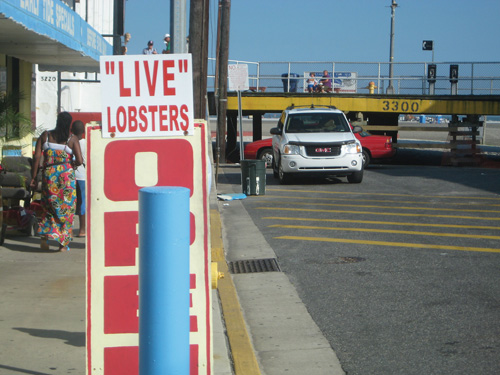
I don’t trust the editorial wisdom of Wikipedia, but according to the masses, common use for quotation marks is apparently “to call attention to ironic or apologetic words.”
Day Old “Bread”
Ironic or apologetic?
Unverifiable fact?
Unfamiliar expression?
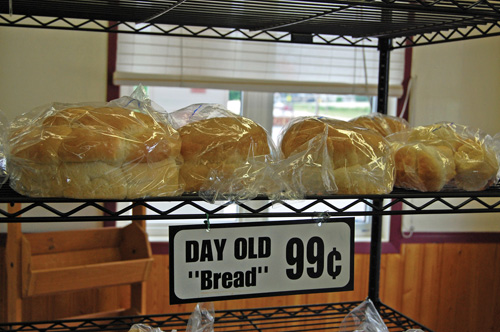
I love the quotation use in this one:
Do “NOT”
PARK here
Please
THESE PARKING SPACES ARE FOR
“CUSTOMERS”

Are we calling attention to the irony that this place has customers? Perhaps it’s all just apologetic.
Bethany Keeley’s The Book of “Unnecessary” Quotation Marks is a collection of photographs of signs in stores, offices, streets and “facilities” making interesting use of our favourite punctuation mark.
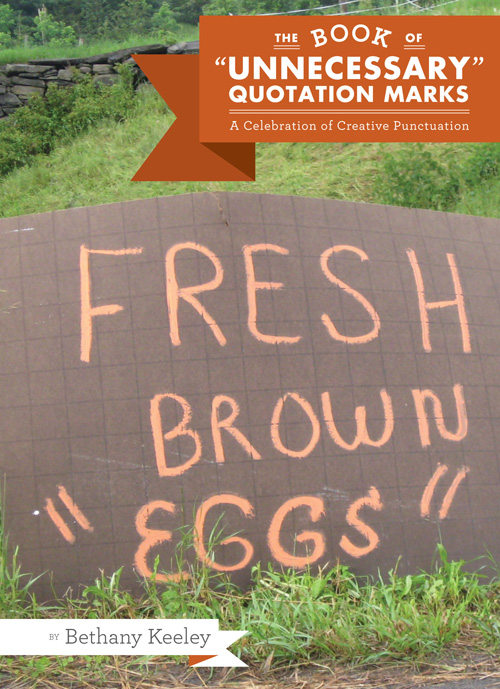
And just because quotation marks can be so confounding. Here is some fun with single and double quotation marks.
Quote: “Don’t be absurd!” said Henry. “To say that‚ ‘I mean what I say’ is the same as‚ ‘I say what I mean’ is to be as confused as Alice at the Mad Hatter’s tea party. You remember what the Hatter said to her: ‘Not the same thing a bit! Why you might just as well say that “I see what I eat” is the same thing as “I eat what I see”!’ ”
The Book of “Unnecessary” Quotation Marks by Bethany Keeley
Published by Chronicle Books
Distributed in Canada by Raincoast Books
Mary McCarthy’s most celebrated novel follows the lives of eight Vassar graduates (Class of ’33), known simply to their classmates as “the group.”
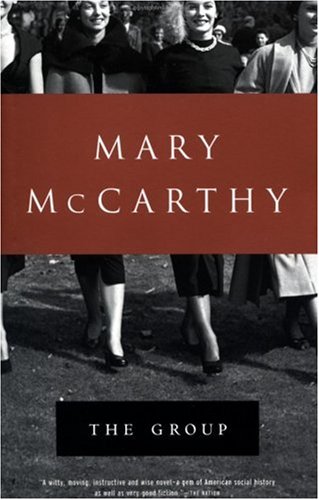
The tangled stories of eight different lives are united by the pivotal figure of Kay Strong–the first of the group to break from the traditions of society by getting married without parental guidance.
The social history presented here, pre-World War II, is equal in period quality to that presented in the tv show Mad Men (if not moreso).
The girls are all middle-class or upper-middle class, growing up during a revolutionary period in American life where women are forming an identity beyond their social class, beyond their parent’s social aspirations.
They work outside the home, they travel abroad alone, they philosophize, they use birth control, they buy this new thing called margarine.
All eight are in some way breaking with the past and forging a new status quo while at the same time falling into prescribed roles.
The language choice is striking and the novel’s structure of twists and turns reveals layers of insights into each character through the commentary and interior monologues of other characters.
McCarthy’s novel was published in 1963, thirty years after the time described in the novel, but the picture she paints of the times seems complete as well as insightful. (I particularly enjoyed the incredibly rich word choice and complex sentence structure. This is a novel written in a different time and its structure is reflective of the times represented.)
Quote: It was plain to Polly that many of her married classmates were disappointed in their husbands and envied the girls, like Helena, who had not got married. In June the class would have its fifth reunion and already it had its first divorcees. These hares were discussed wistfully by the tortoises of the class. It was felt that they at least had ‘done something.’ Norine Blake’s divorce, she had gone to a ranch outside Reno and now called herself ‘Mrs. Schmittlapp Blake’, had earned her a place of renowned in alumnae affairs equal to that of Connie Storey, who had become a model for Bergdorf, or of Lily Marvin, who dressed windows for Elizabeth Arden, and outranking poor Binkie Barnes, who was working as CIO organizer, and Bubbles Purdy, who was studying to be a preacher.
“A witty, moving, instructive and wise novel, a gem of American social history as well as very good fiction.” , The Nation
I concur.
It’s been a trying week but I have enjoyed the following:
“Adversity is just change that we haven’t adapted ourselves to yet.” —Aimee Mullins
I’m reading Nicolas Carr’s The Shallows about how the internet is changing our brains.
“The secret of life…is to fall seven times and to get up eight times.” —Paulo Coelho, from The Alchemist
I’m cheering for James’ grandpa who is recovering from a stroke.
“Each moment of our life, we either invoke or destroy our dreams.” —Stuart Wilde
Always good to remind yourself of this one.
“If you want to build a ship, don’t drum up people to collect wood and don’t assign them tasks and work, but rather teach them to long for the endless immensity of the sea.” —Antoine De Saint Exupery
Important thought as I consider how and what to teach in my new SFU course this fall: Online Marketing for Publishers.
“Never doubt that a small group of thoughtful, committed citizens can change the world.” —Margaret Mead
Hope is light.
“I thought how unpleasant it is to be locked out; and I thought how it is worse, perhaps, to be locked in.” —Virginia Woolf
I will not compare myself to others. The grass on this side is lovely, thank you.
“I’ve learned that people will forget what you said, people will forget what you did, but people will never forget how you made them feel.” —Maya Angelou
Be a good buddy.
“Don’t hire a dog, then bark yourself” —David Ogilvy
Man, was he right.
“Nobody cares if you can’t dance well. Just get up and dance. Great dancers are not great because of their technique, they are great because of their passion.” —Martha Graham
Yes, this is my own interpretive dance.
“Never allow a person to tell you no who doesn’t have the power to say yes.” —Eleanor Roosevelt
Amen.
“I don’t want to get to the end of my life and find that I lived just the length of it. I want to have lived the width of it as well.” –Diane Ackerman
Going out on a school night!
“It takes a great deal of courage to stand up to your enemies, but even more to stand up to your friends.” —J. K. Rowling
Courage is a valuable asset. (And all my friends are lovely, thank you for being so.)
© 2024 So Misguided
Theme by Anders Noren — Up ↑